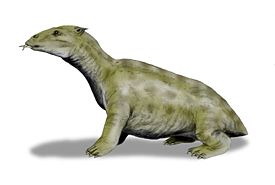- Desmostylia
-
Desmostylia
Temporal range: Late Oligocene–Late Miocene
Desmostylus Scientific classification Kingdom: Animalia Phylum: Chordata Class: Mammalia Infraclass: Eutheria Superorder: Afrotheria Order: †Desmostylia
Reinhart, 1953Families and genera - Family †Desmostylidae
- Family †Paleoparadoxiidae
- †Ashoroa
- †Paleoparadoxia
- †Cornwallius
- †Vanderhoofius
Desmostylia (Greek for "bonded pillars") is an extinct order of marine mammals which existed from the Arikareean age of the late Oligocene epoch (30.8 million years ago) to the Tortonian age of the late Miocene epoch (7.25 million years ago). Their dental and skeletal form suggests desmostylians were amphibious herbivores dependent on littoral habitats. Their name refers to their highly distinctive molars, in which each cusp was modified into hollow columns, so that a typical molar would have resembled a cluster of pipes, or in the case of worn molars, volcanoes. (This shows the close relationship between the Paenungulata, to which this group belongs, and the Tubulidentata.)
Desmostylian fossils are known from the northern Pacific rim, from southern Japan through Russia, the Aleutian Islands and the Pacific coast of North America to the southern tip of Baja California. Though the type species Desmostylus hesperus was originally classified from a few teeth and vertebrae as a sirenian by Marsh in 1888, doubts arose a decade later when more complete fossils were discovered in Japan. In 1898, American geologist Henry Fairfield Osborn, working with Japanese paleontologists S. Yoshiwara and J. Iwasaki, suggested a proboscidean origin based on skull and tusk similarities to early mastodons. One of the most comprehensive collections of desmostylian teeth was amassed by paleontologist John C. Merriam, who concluded based on the molar structure and repeated occurrence in marine beds that the animals had been aquatic, and were probably sirenian. Other scientists suggested origins with monotremes like the duck-billed platypus. Because desmostylians were originally known only from skull fragments, teeth and bits of other bones, general agreement was that they had had flippers and a fin-like tail. The discovery of a complete skeleton from Sakhalin Island in 1941, however, showed that they possessed four legs, with bones as stout as a hippopotamus', and justified the creation of a new order for the desmostylians, described by Roy H. Reinhart in 1953.
Despite their similarities to manatees and elephants, desmostylians were entirely unlike any living creatures. Douglas Emlong's 1971 discovery of the new genus Behemotops from Oregon showed that early desmostylians had more proboscidean-like teeth and jaws than later ones. Despite this discovery, their relationships to manatees and proboscids remain unresolved.
Desmostylians grew to 1.8 metres (6 ft) in length and are thought to have weighed more than 200 kilograms (440 lb).
External links
- Introduction to Desmostylia
- Desmostylus (in Dutch)
Categories:- Desmostylians
- Miocene extinctions
- Prehistoric mammals
Wikimedia Foundation. 2010.

